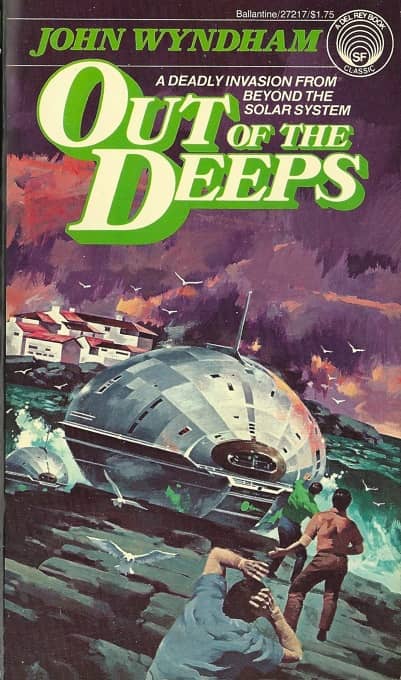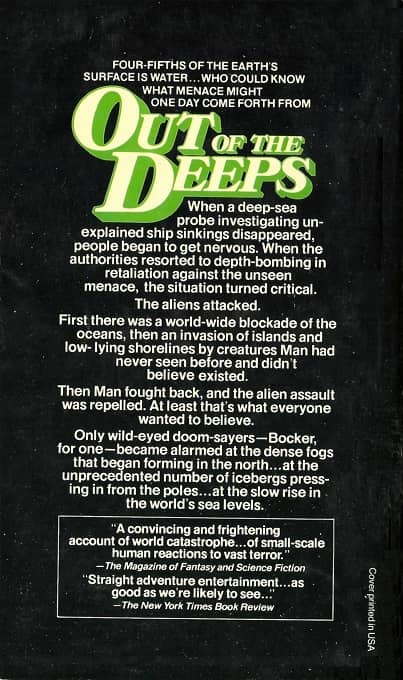Vintage Treasures: Out of the Deeps by John Wyndham
 |
 |
Del Rey / Ballantine edition, 1977. Art by Vincent Di Fate
John Wyndham is best remembered these days for his classic SF horror novels The Day of the Triffids (1951), The Chrysalids (1955), and The Midwich Cuckoos (1957) (filmed twice as Village of the Damned, the second time by John Carpenter). But he had a lengthy career in the pulps, publishing dozens of stories in Amazing Stories, Wonder Stories, and other places under the name John Beynon Harris and John Beynon. Much of his early pulp fiction was collected in Sleepers of Mars (Coronet Books, 1973) and two volumes of The Best of John Wyndham (Sphere Books, 1973).
He published seven novels under the name John Wyndham between 1951 – 1968, starting with The Day of the Triffids, and these are the books that made his reputation. The second was The Kraken Wakes (1953), published in the US as Out of the Deeps. Like most of his Wyndham material, it has been continuously in print for most of the past six decades. In a 2009 review at Tor.com, Jo Walton wrote:
I’d remembered it as being a cosy catastrophe where the world is destroyed by sea monsters, and rather second-tier Wyndham, but I’d done it an injustice. The Kraken Wakes is quite an unusual cosy catastrophe, and really much more interesting than I’d remembered it.
To start with, it’s an alien invasion. The first things are “red dots,” fiery meteors landing in the deep sea, which are actually alien craft. It’s speculated that they might come from Jupiter or Neptune and like living at high pressure under water, and it’s speculated that humanity could share the planet with them, since they need different things. The rest of the book is a series of attacks by the aliens, never called krakens in the book, culminating in the scene that starts the novel where rising sea water and icebergs in the Channel have entirely changed the climate and landscape of Britain and the protagonists are trying to escape. This is essentially the story of how some very unusual aliens conquer the world in 1953, and it’s much closer to The War of the Worlds than it is to Wyndham’s other novels.
I never managed to acquire a copy until two weeks ago, when I tracked down the handsome Del Rey reprint above, with the fine Di Fate cover (Del Rey reprinted several Wyndham paperbacks at the same time, including The Midwich Cuckoos, which I discussed here). The Del Rey edition is a nice slender book (182 pages), and looks like a perfect summer read. It’s been too long since I’ve read Wyndham, and I’m very much looking forward to it.
I have the Penguin version of The Kraken Wakes with the uninteresting (to me) Harry Willock cover. It has been on my shelf waiting to be read for ages. Believe it or not, I am that pathetic that had I this one with the Vincent DiFate cover, or even earlier Ballentines with Richard Powers covers or the Penguins with the Peter Lord or Mark Salwowski covers and I probably would have read it.
Oh, that doesn’t make you pathetic. Cover art has a HUGE impact on how interested I am in reading a book. When I have multiple editions, I always want to read the one with the best cover!
I had this edition. It’s a wonderfully bonkers story told with a completely straight face. No bells and whistles here. Just pure story. I love it!
> No bells and whistles here. Just pure story. I love it!
Doug,
I haven’t read as much Wyndham as I should, but I find him a very pure writer in the adventure sense. His stories are lean and fast paced.
Quite a belated post here. This article inspired me to finally give the book the attention it richly deserves. Having been on my shelf since around 1992 with only an abortive attempt that I doubt saw me past the first 5 pages, giving it the proverbial bash could be considered somewhat overdue.
Well I am glad I did! The novel was thoroughly enjoyable. It is well written and thought provoking. While based on 1950’s sentiments many aspects could be as easily applied today as then. Indeed there are topics I won’t delve into in fear of ruining the story for others that, at a far more real world mundane level are topical and possible more pertinent today than ever.
The book does start off slow. For readers who want to get to the action fast (like my younger self) I beg you to persevere. The book is divided into three phases with the first and longest phase being used for scene setting. The story itself while dealing with an alien invasion of sorts is far from War of the Worlds. Indeed the action “moves like molasses”. But that’s the whole point. This is not a glib quick invasion quick solution novel, it is a thought provoking and realistic take on an, even by the 1950’s, well trodden subject.
I liked the characters, they were real, with real life motivations, concerns and problems. The author doesn’t spell out much. Indeed if you are inattentive you may miss some important information also most hidden in the text.
All I can further say is you should read this book. Try to get the one with the cool cover art John posted in this article, so my for the sake of the cover. I look forward to reading The Trouble with Lichen or The Day of the Triffids, both of which are on my shelf but have thankfully not been in status quite as link as this one was.